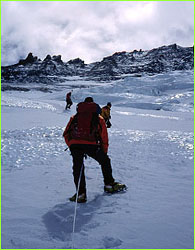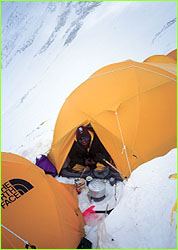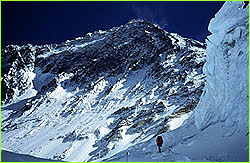
|
 |
 |
Thin Air by Liesl Clark "We're paying the price for climbing to Camp III and then not descending to Camp II for the night....Pete had an altitude headache last night and my vision is blurred this morning."A Portrait of Camp III Pulse:165  David Breashears pulls up on the rope that is fixed to the
Lhotse Face,
takes a couple of labored breaths, kicks in his crampons, and
pulls up again. Camp III still remains a distant goal, 700
feet away and above several steep ice bulges. It hasn't
appeared any closer in the last hour despite David's
exhaustive efforts. Pete Athans is 100 feet below, shooting
digital video of David moving up the Lhotse Face. As they move
higher in tandem, the air becomes thinner and their breaths
more frequent.
David Breashears pulls up on the rope that is fixed to the
Lhotse Face,
takes a couple of labored breaths, kicks in his crampons, and
pulls up again. Camp III still remains a distant goal, 700
feet away and above several steep ice bulges. It hasn't
appeared any closer in the last hour despite David's
exhaustive efforts. Pete Athans is 100 feet below, shooting
digital video of David moving up the Lhotse Face. As they move
higher in tandem, the air becomes thinner and their breaths
more frequent.At about 24,000 feet, tents come into vision and Camp III is within reach. The first order of business is to pitch your tent on the gently undulating hanging glacier that is Camp III. David and Pete literally have to tuck themselves into a wall of blue ice 25 feet high. Small tent-sized terraces must be dug out of  this frozen slope, which drops off at a 35-degree angle. At
first, the drifted snow is easy to shovel out, but once you
dig down two feet you hit hard blue ice.
this frozen slope, which drops off at a 35-degree angle. At
first, the drifted snow is easy to shovel out, but once you
dig down two feet you hit hard blue ice. After two hours' work, David and Pete have chopped out a level sleeping place. Camp III is burgeoning; four feet to the left and slightly downhill is a Canadian team tent. 20 feet diagonally to the right is a Mal Duff Lhotse team tent, while 40 feet directly below, hacking away at blue ice, two Sherpas put in a second tent for Mal Duff's Lhotse team. More tents will inevitably spring up over the next few days, as other expeditions and team members reach this point in the climb. Camp III has the most beautiful camp view on Everest. 1000 feet higher and to the left is the long horizontal Nuptse ridge. Dominating the view and directly in front of the tents, some 20 miles away, is the sixth highest mountain in the world, Cho Oyu (climbed twice by Ed Viesturs). To the right, towering thousands  of feet overhead, is the massive rocky southwest face of
Everest. The Western Cwm stretches 3,000 feet down below until
it stops at the tip of the Khumbu Icefall at Camp I. There,
scattered on the rock and snow moraine, the camps from the
many other Everest expeditions dot the terrain with their red,
blue, green, brown, and yellow tents.
of feet overhead, is the massive rocky southwest face of
Everest. The Western Cwm stretches 3,000 feet down below until
it stops at the tip of the Khumbu Icefall at Camp I. There,
scattered on the rock and snow moraine, the camps from the
many other Everest expeditions dot the terrain with their red,
blue, green, brown, and yellow tents.From Camp III's vantage, it's a good place to take stock of who's where on the mountain. David radios down to Base Camp to report that they've dug in their  tent and observes, "If I look straight above me, 1,500 feet to
the (link) Yellow Band, I can see six climbers with loads on
their way to Camp IV. Then on the traverse from the Yellow
Band, I can see four tiny little dots laboring their way up to
the crest of the (link) Geneva Spur.
tent and observes, "If I look straight above me, 1,500 feet to
the (link) Yellow Band, I can see six climbers with loads on
their way to Camp IV. Then on the traverse from the Yellow
Band, I can see four tiny little dots laboring their way up to
the crest of the (link) Geneva Spur. Two of the climbers are Jangbu, our Sirdar, and Kami, one of our climbing Sherpas. We find out later that they climbed part way to the South Col, but had to turn around because a recent snowfall had covered over the fixed ropes. Freeing the ropes from the snow cover takes a lot of effort, so Jangbu and Kami headed back down to Camp II for the night. They dropped their loads at the Geneva Spur at 2:00 pm and began their descent back down to Camp II, passing David and Pete's tent on their way. They reached Camp II at 5:00 and then fell into their tents for a much needed night of sleep. Continue: A Day in the Life at Camp III Lost on Everest | High Exposure | Climb | History & Culture | Earth, Wind, & Ice E-mail | Previous Expeditions | Resources | Site Map | Everest Home Editor's Picks | Previous Sites | Join Us/E-mail | TV/Web Schedule About NOVA | Teachers | Site Map | Shop | Jobs | Search | To print PBS Online | NOVA Online | WGBH © | Updated November 2000 |